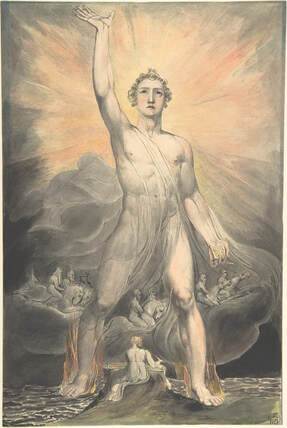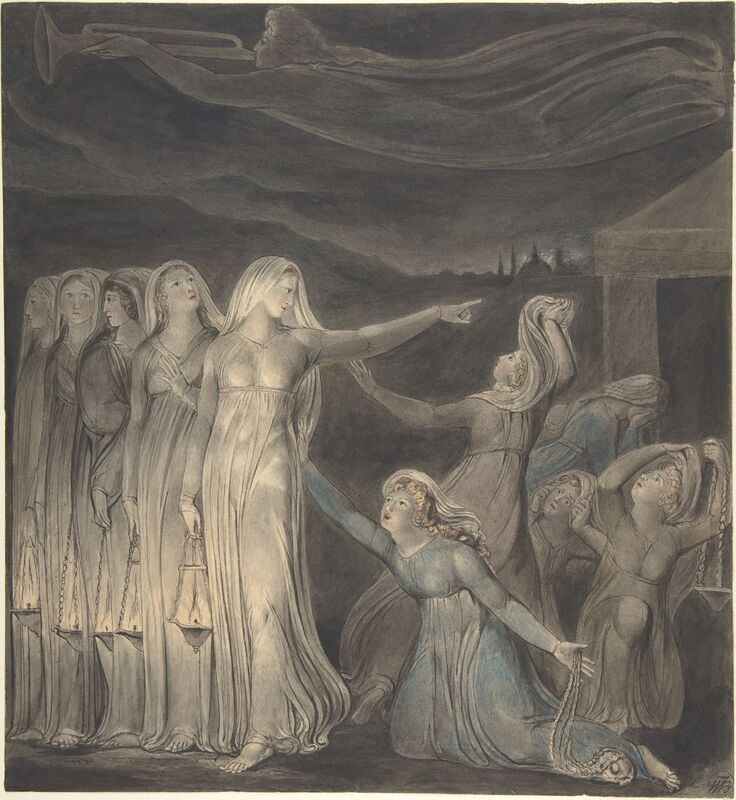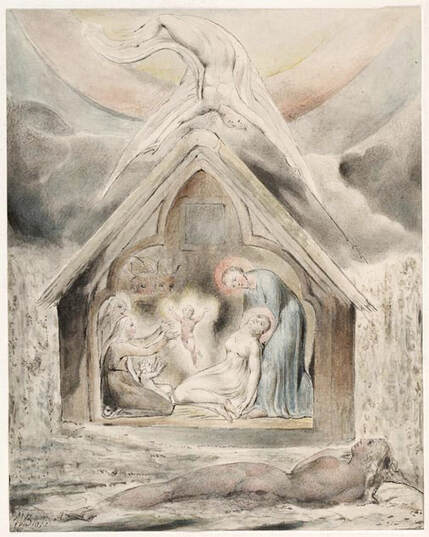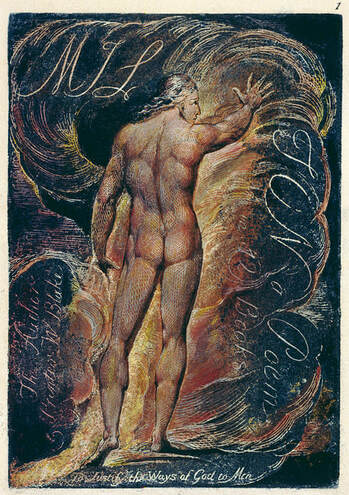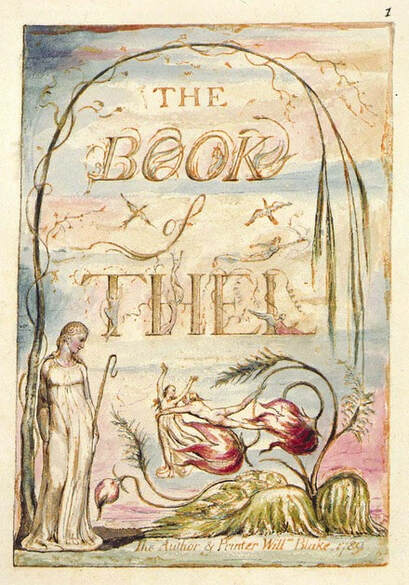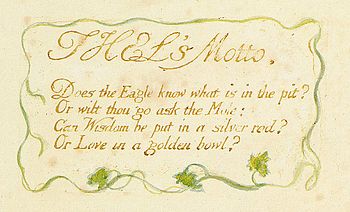The following paintings by William Blake were in the collection of BG Windus.
There may be other paintings which have not as yet been connected with the Windus Collection.
There may be other paintings which have not as yet been connected with the Windus Collection.
The poet, painter, printmaker and mystic, William Blake, like JMW Turner, was a Londoner (indeed while Turner's father was placing his son's drawings on display in the window of his barber shop in Covent Garden, Blake was living only a 20 minute walk away in Soho). And like Turner his artistic ability was recognised at a young age; by 10 he was enrolled in Henry Pars' drawing school. At 14 Blake began an apprenticeship under James Basire, engraver to the Society of Antiquaries and the Royal Society. In 1779 he became a student at the Royal Academy where he also exhibited his work, Turner would follow 11 years later. In addition to printing his own manuscripts and illuminated books, Blake continued to engrave illustrations for London booksellers. His wife, Catherine Boucher, assisted with the colouring of the works.
Blake’s work was influenced by the visions he had experienced from childhood. He was an ardent believer in the freedom of imagination and hated rationalism and materialism. In the final years of his life, Blake suffered from recurring bouts of an unknown disease that he called "that Sickness to which there is no name" possibly due to prolonged exposure to the fumes produced when acid is applied to copper plates. His fortunes varied throughout his life and it was only when Gilchrist's Life of William Blake, Pictor Ignotus appeared in 1863, that his reputation was finally secured as a major poet and artist.
BG Windus also collected the work of two of Blake’s friends, Thomas Stothard and Henry Fuseli.
For more information on Blake go to The William Blake Archive
Blake’s work was influenced by the visions he had experienced from childhood. He was an ardent believer in the freedom of imagination and hated rationalism and materialism. In the final years of his life, Blake suffered from recurring bouts of an unknown disease that he called "that Sickness to which there is no name" possibly due to prolonged exposure to the fumes produced when acid is applied to copper plates. His fortunes varied throughout his life and it was only when Gilchrist's Life of William Blake, Pictor Ignotus appeared in 1863, that his reputation was finally secured as a major poet and artist.
BG Windus also collected the work of two of Blake’s friends, Thomas Stothard and Henry Fuseli.
For more information on Blake go to The William Blake Archive
Angel of the Revelation (Book of Revelation, chapter 10) ca. 1803–5
|
This work comes from a series of eighty biblical watercolors that Blake made for Thomas Butts, an important patron. He found the subject in chapter 10 of the book of Revelation and describes both the author and his vision. A diminutive Saint John, pen in hand, on the island of Patmos, gazes at a "mighty angel . . . clothed with a cloud . . . a rainbow was upon his head, and his face was as it were the sun, and his feet as pillars of fire." The artist based the angel's water-spanning stance on prints of the ancient Colossus of Rhodes and envisioned the seven thunders described in the text as horsemen riding through clouds. Provenance: Thomas Butts (British); Benjamin Godfrey Windus (British); Thomas Butts Jr. (British); Sotheby's, London (British), March 26, 1852, lot 154; Henry George Bohn (British), bought at the preceding; Benjamin Godfrey Windus (British), to the following; Mrs. J. K de Putron, daughter of the preceding, by 1863, sold at the following; Anonymous seller, Christie's, London, March 16, 1912, lot 5, bought by Sabin; Frank T. Sabin (British); Vendor: Frank T. Sabin (British) Blake painted four versions of this subject for his patron Thomas Butts and this lucid watercolor is the earliest. The wise virgins at left are elegant, palely luminous, and composed within a single plane, recalling classical low-relief sculpture. In contrast, their foolish companions at right are agitated and characterized by dark tones. The drawing illustrates a parable in Matthew 25:1-13 used by Jesus to warn listeners to be spiritually prepared: Then shall the kingdom of heaven be likened unto ten virgins, which took their lamps, and went forth to meet the bridegroom. And five of them were wise, and five were foolish. They that were foolish took their lamps, and took no oil with them. But the wise took oil in their vessels with their lamps. A trumpeting angel flying overhead signifies that the moment of judgment has arrived. Provenance: Thomas Butts (British); Thomas Butts Jr. (British), sold at the following; Sotheby's, London (British), March 26, 1852, lot 165; Henry George Bohn (British), purchased at the preceding; Benjamin Godfrey Windus (British); Mrs. J. K de Putron, daughter of the preceding, by 1863, sold at the following; Anonymous seller, Christie's, London, March 16, 1912, lot 4; Frank T. Sabin (British), bought at the preceding; Vendor: Frank T. Sabin (British) The approximate date of composition is established by stylistic considerations. The coloristic effects and delicate surfaces built with small brush strokes in the "Nativity Ode" designs associate them with Blake's illustrations to Milton's Paradise Regained, "L'Allegro," and "Il Penseroso," all of which include designs on paper with an 1816 watermark. The lapidary surfaces of these works, dated to c. 1816-20 in Butlin, are more highly wrought than in the "Nativity Ode" water colors, and thus a date of c. 1815 seems likely. Provenance: Acquired directly from Blake, and probably commissioned, by Thomas Butts; by inheritance in 1845 to his son, Thomas Butts, Jr.; sold anonymously, Sotheby's, 26 March 1852, lot 147, "with the poem in MS." (£6.12s.6d. to the dealer Henry G. Bohn); B. G. Windus; probably by inheritance or gift to his daughter, Mrs. J. K. de Putron, by 1863; sold anonymously, Christie's, 16 March 1912, lot 6 (£336 to the dealer Frank T. Sabin); offered by the Rosenbach Company, December 1912 catalogue, item 11 (not priced) and in Rosenbach's November 1913 catalogue 17, item 61 ($9500); sold October 1916, with Blake's Satan, Sin, and Death (Butlin 536.2), to Henry E. Huntington ($10,000, according to Rosenbach's receipt in the Huntington archives). |
Additional information in the William Blake Archive notes:
The manuscript copy of the poem sold with the water colors in 1852 may have included only the passages illustrated, not the entire poem. Butlin 542 claims, without providing any evidence, that this manuscript contained "Milton's verses in Blake's hand," apparently like those Blake wrote in pen and ink on separate sheets that accompany his illustrations to Milton's "L'Allegro" and "Il Penseroso" (Butlin 543). This manuscript may have been lost or discarded prior to the 1912 auction, the catalogue of which makes no mention of such texts. Until 1993, the "Nativity Ode" water colors were pasted to backing mats, probably made for Rosenbach, with passages from the poem written below each design in fine italic script. The relationship, if any, between these mat inscriptions and the earlier manuscript is not known.
An auction at Sotheby, Wilkinson & Hodge on 10 - 11 December 1923
The Sotheby auction records the following sale of books and manuscripts by William Blake (and Drawings by T. Stothard) which were originally in the Windus Collection:
Catalogue of Valuable Printed Books, Illuminated & Other Manuscripts, Drawings, Caricatures & Book-Plates, Autograph Letters, Literary Relics, etc. ... Comprising ... Very Fine Copies of William Blake's MILTON and THEL, and a Collection of Over 1500 Drawings by T. Stothard, formerly in the Library of the Late B.G. Windus, Esq. ... (London, 1923) <Bodley>
Books of the late Rev. G.P. de Putron "formerly in the library of [his grandfather] the late B.G. Windus"
252 Milton [D], 50 leaves, 10⅞ x 8½", watermark 1815 on one leaf, printed in orange on one side only, magnificently
coloured, some gold; with The Book of Thel [O], 8 leaves, printed in orange on one side only, coloured, no watermark,
half calf [£3,400 to Pickering]
Catalogue of Valuable Printed Books, Illuminated & Other Manuscripts, Drawings, Caricatures & Book-Plates, Autograph Letters, Literary Relics, etc. ... Comprising ... Very Fine Copies of William Blake's MILTON and THEL, and a Collection of Over 1500 Drawings by T. Stothard, formerly in the Library of the Late B.G. Windus, Esq. ... (London, 1923) <Bodley>
Books of the late Rev. G.P. de Putron "formerly in the library of [his grandfather] the late B.G. Windus"
252 Milton [D], 50 leaves, 10⅞ x 8½", watermark 1815 on one leaf, printed in orange on one side only, magnificently
coloured, some gold; with The Book of Thel [O], 8 leaves, printed in orange on one side only, coloured, no watermark,
half calf [£3,400 to Pickering]
According to the William Blake Archive the two volumes Milton [D] and The Book of Thel [O},
still bound together, were given to the Library of Congress in 1945.
still bound together, were given to the Library of Congress in 1945.
The William Blake Archive
Over the course of two centuries, respect for the prints, paintings, and poems of William Blake (1757-1827) has increased to a degree that would have astonished his contemporaries. Today both his poetry and visual art in several media are admired by a global audience. In the broadest terms, the William Blake Archive is a contemporary response to the needs of this dispersed and various audience of readers and viewers and to the corresponding needs of the collections where Blake's original works are currently held. The William Blake Archive
Milton [poem c.1804 - 1811]
The Book of Thel [poem 1789]
Click to view all of the pages of The Book of Thel or download pdf
|
Frontispiece to Milton. Bound with The Book of Thel Copy O in modern half tan calf over marbled boards with an earlier morocco spine pasted over the calf There are numerous pencilled corrections and changes by Blake. Stab Holes originally stabbed through six holes, 4.1, 3.9, 4.4, 4.5, and 4.5 cm. apart; later stabbed through twelve holes when bound with The Book of Thel Copy O Provenance: Originally acquired from Blake by James Vine; bound with The Book of Thel Copy O and sold from his collection at Christie's, 24 April 1838, lot 297 (£5.12s.6d. to the dealer Henry Bohn); B. G. Windus; G. P. de Putron by inheritance; sold Sotheby's, 11 Dec. 1923, lot 252 (£3400 to the dealer Pickering); Frank Bemis by 1925; the dealer A. S. W. Rosenbach; Lessing J. Rosenwald in 1939, who gave both works to the Library of Congress in 1945. Bound with Milton Copy D in half calf over marbled boards, an earlier morocco backstrip pasted over the calf Provenance: Originally acquired from Blake by James Vine; bound with Milton Copy D and sold from Vine's collection, Christie's, 24 April 1838, lot 297 (£5.12s.6d. to the dealer Henry Bohn); offered by Bohn, 1841 Catalogue of Books, item 178 (not priced) and Catalogue of Books, 1847 and 1848 issues, vol. 1, page 259, no item number (£10.10s.); Benjamin Godfrey Windus; G. P. de Putron by inheritance in 1867; sold Sotheby's, 11 Dec. 1923, lot 252 (£3400 to "Pickering"—probably the book dealer Pickering & Chatto, possibly acting from Frank Bemis); Bemis no later than 1925; sold in 1939 through the dealer A. S. W. Rosenbach to Lessing J. Rosenwald, who gave the two works still bound together to the Library of Congress in 1945. |

